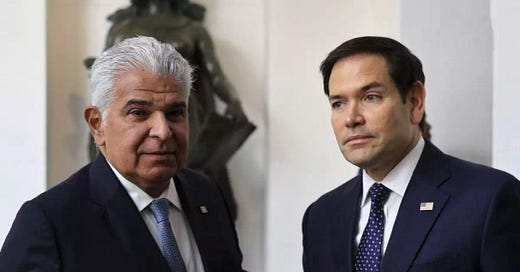Originally published in El Boletín, the Latin American newsletter of The Economist
Last month I was sitting in the back of a battered yellow taxi as it made its way past the seafront skyscrapers towards Panama’s presidential palace. The driver, a young man in ripped jeans, eyed my suit and tie in the rearview mirror. “You going to see Marco Rubio?” he asked.
In a country that loves its boxing, the meeting between the US secretary of state and Panamanian President José Raúl Mulino had been as hotly anticipated as a heavyweight fight. In response to Donald Trump’s threats to “take back” the Panama Canal, Mr Mulino had retorted that “every square metre” of the waterway would remain in Panamanian hands.
But my driver wasn’t backing the home fighter. “Tell Rubio to kick those white-collar criminals out of the canal,” he said. “We’re not going to defend sovereignty or independence or any of that. We just want food, work, health care. Que venga Trump! (Let Trump come)”.
In the early weeks of the diplomatic crisis, public opinion was divided. Those old enough to remember the struggle to gain sovereignty of the canal in the 1960s—or 1989’s Operation Just Cause, when the United States overthrew Manuel Noriega, resulting in thousands of civilian deaths—were generally appalled by Mr Trump’s threats. Trade unionists burned the stars and stripes outside the American embassy.
But protests never reached the size or intensity of the mass demonstrations that shut down the country in October 2023. What began as a protest against a huge open-pit copper mine, morphed into a wider mobilisation against the perceived corruption of the rabiblancos, Panama’s political and business elite. Many young Panamanians, including my driver, feel that the proceeds of the canal, the mine and other major projects are siphoned off by the few. Panama is one of the world’s most unequal countries.
In February, a video went viral highlighting the comptroller general’s claims that Panama Ports, the Hong Kong-owned company in Mr Rubio’s diplomatic cross-hairs, had not paid a “single cent” to the state over the last three years. Again, this prompted anger with the rabiblancos rather than the Chinese. Some of those espousing Que venga Trump! seem to hold the (optimistic) belief that the United States will clean up their country’s rampant corruption. Others just wanted to see the rabiblancos squirm.
After Mr Rubio’s visit it became clear that the Panamanian government had thrown in the towel. Mr Mulino immediately announced that his country would not renew its membership of China’s Belt and Road infrastructure program. Three weeks later Panama received 299 third-country migrants deported from the United States. Two weeks after that, Panama Ports was sold to American investors.
Panamanians have learned the hard way that Mr Trump fights dirty. Mr Rubio’s visit may have scared the rabiblancos, but the subsequent concessions have not stopped President Trump repeating his plans to “reclaim” the canal, most recently in his address to Congress last Tuesday. Having achieved his strategic goals, it would be an act of spite rather than necessity. If an occupation were to occur now, a Washington source texted me, they should call it “Operation Just ‘Cos.”



